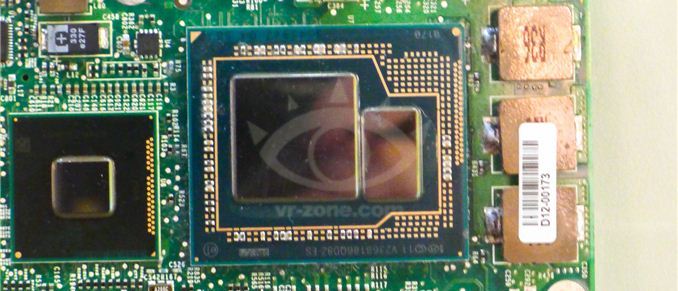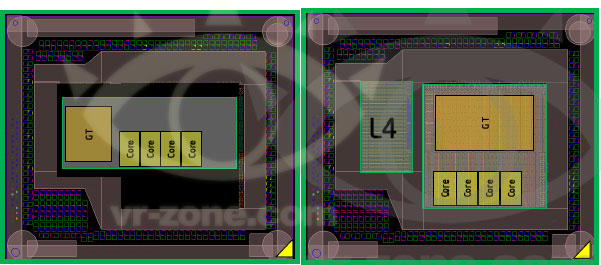Intel's Return to DRAM: Haswell GT3e to Integrate 128MB eDRAM?
by Anand Lal Shimpi on April 23, 2013 11:58 AM EST
We've known for a while now that Intel will integrate some form of DRAM on-package for the absolute highest end GPU configurations of its upcoming Haswell SoC. Memory bandwidth is a very important enabler of GPU (and multi-core CPU) performance, but delivering enough of it typically required very high speed interfaces (read: high power) and/or very wide interfaces (read: large die areas). Neither of the traditional approaches to scaling memory bandwidth are low power or cost effective, which have kept them out of ultra mobile and integrated processor graphics.
The days of simple performance scaling by throwing more transistors at a design are quickly coming to an end. Moore's Law will continue but much like the reality check building low power silicon gave us a while ago, building high performance silicon will need some out of the box thinking going forward.
Dating back to Ivy Bridge (3rd gen Core/2012), Intel had plans to integrate some amount of DRAM onto the package in order to drive the performance of its processor graphics. Embedding DRAM onto the package adds cost and heat, and allegedly Paul Otellini wasn't willing to greenlight the production of a part that only Apple would use so it was canned. With Haswell, DRAM is back on the menu and this time it's actually going to come out. We've referred to the Haswell part with embedded DRAM as Haswell GT3e. The GT3 refers to the GPU configuration (40 EUs), while the lowercase e denotes embedded DRAM. Haswell GT3e will only be available in a BGA package (soldered-on, not socketed), and is only expected to appear alongside higher TDP (read: not Ultrabook) parts. The embedded DRAM will increase the thermal load of the SoC, although it shouldn't be as painful as including a discrete GPU + high speed DRAM. Intel's performance target for Haswell GT3e is NVIDIA's GeForce GT 650M.
What we don't know about GT3e is the type, size and speed of memory that Intel will integrate. Our old friend David Kanter at RealWorldTech presented a good thesis on the answers to those questions. Based on some sound logic and digging through the list of papers to be presented at the 2013 VLSI Technology Symposium in Kyoto, Kanter believes that the title of this soon to be presented Intel paper tells us everything we need to know:
"A 22nm High Performance Embedded DRAM SoC Technology Featuring Tri-Gate Transistors and MIMCAP COB"
According to Kanter's deductions (and somewhat validated by our own sources), Haswell GT3e should come equipped with 128MB of eDRAM connected to the main SoC via a 512-bit bus. Using eDRAM vs. commodity DDR3 makes sense as the former is easier to integrate into Intel's current fabs. There are also power, manufacturability and cost concerns as well that resulted in the creation of Intel's own DRAM design. The interface width is a bit suspect as that would require a fair amount of area at the edges of the Haswell die, but the main takeaway is that we're dealing with a parallel interface. Kanter estimates the bandwidth at roughly 64GB/s, not anywhere near high-end dGPU class but in the realm of what you can expect from a performance mainstream mobile GPU. At 22nm, Intel's eDRAM achieves a density of around 17.5Mbit/mm^2, which works out to be ~60mm^2 for the eDRAM itself. Add in any additional interface logic and Kanter estimates the total die area for the eDRAM component to be around 70 - 80mm^2. Intel is rumored to be charging $50 for the eDRAM adder on top of GT3, which would deliver very good margins for Intel. It's a sneaky play that allows Intel to capture more of the total system BoM (Bill of Materials) that would normally go to a discrete GPU company like NVIDIA, all while increasing utilization of their fabs. NVIDIA will still likely offer better perfoming solutions, not to mention the benefits of much stronger developer relations and a longer history of driver optimization. This is just the beginning however.

Based on leaked documents, the embedded DRAM will act as a 4th level cache and should work to improve both CPU and GPU performance. In server environments, I can see embedded DRAM acting as a real boon to multi-core performance. The obvious fit in the client space is to improve GPU performance in games. At only 128MB I wouldn't expect high-end dGPU levels of performance, but we should see a substantial improvement compared to traditional processor graphics. Long term you can expect Intel to bring eDRAM into other designs. There's an obvious fit with its mobile SoCs, although there we're likely talking about something another 12 - 24 months out.
AMD is expected to integrate a GDDR5 memory controller in its future APUs, similar to what it has done with the PlayStation 4 SoC, as its attempt to solve the memory bandwidth problem for processor based graphics.
Source: RealWorldTech










83 Comments
View All Comments
JPForums - Tuesday, April 23, 2013 - link
I would also find a Surface Pro based on this chip appealing. Unfortunately, I doubt you'll see a processor with higher than ultrabook power draw in a Surface Pro. It suck, though, as people with a lumberjack build, like me, wouldn't care about an extra Kg in batteries and cooling system.FITCamaro - Tuesday, April 23, 2013 - link
Well the Surface Pro is already not "thin". But yeah I don't care about the extra weight.This Guy - Wednesday, April 24, 2013 - link
It's thin compared to the previous few years of wintel tablets. And it costs less than a two year gym membership!Mr Perfect - Tuesday, April 23, 2013 - link
Not to be that guy, but has Intel been talking about stepping up their graphics driver development as well? GT650 performance would be enough to run quite a few games at reasonable settings, but without vigilant driver updates it all means nothing.tipoo - Tuesday, April 23, 2013 - link
That's true, the Sandy Bridge GPUs are already running behind on GPU drivers and they're fairly new.tipoo - Tuesday, April 23, 2013 - link
Meanwhile Nvidia still updates ridiculously old cards.marc1000 - Tuesday, April 23, 2013 - link
I wonder how would 128mb of cache behave on server loads... Maybe intell will do some variaton of this chip later for servers!tipoo - Tuesday, April 23, 2013 - link
That was my thought, the Power7 uses eDRAM too for those kinds of high end loads, I wonder if this will go to the server space with the Xeons too.name99 - Saturday, April 27, 2013 - link
Exactly. I think the emphasis on the GPU aspect of it is short-sighted --- interesting if it somehow affects your Haswell buying decision, but no more than that.The larger story here is Intel finally adopting eDRAM as the next step in increasing performance. As always Intel is being cautious this time giving us one specialty part with something of an add-on. But the interesting question is where do we go with this when it's ready for the big-time? In particular: do we remove the current L3, give each core a beefed up L2 (maybe 1MB or so), and move to an eDRAM L3 of 128 (or 256?, or 384?) MB?
I guess it all hinges on how close Intel can get that eDRAM to the CPU. Can they manufacture it on the same chip? or are we finally ready for the sort of chip-to-chip (as opposed to package-to-package) contact solutions people have been talking about for years?
holmberg - Tuesday, April 23, 2013 - link
I'll be interested to see how embedded RAM works in a Xeon CPU.First, as an L4 cache. At my job, we develop an in-memory database that is typically deployed on a machine with 1 or 2 TB of DRAM and multiple CPUs in a NUMA configuration connected by Intel's QPI. So near and far memory, where caching far memory in near memory could make a big difference.
But secondly, we have experimented with performing certain calculations (statistics, predictive analytics, etc) on the GPU. The trouble was moving the data from the CPU memory to the GPU memory, and then moving the results back. I'm wondering if on a Xeon with an embedded GPU (yeah, I know, doesn't exist today), if the embedded DRAM would be shared between the CPU and GPU so that the data wouldn't have to be moved.
Any thoughts on that?